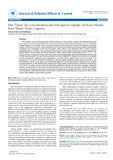| dc.contributor.author | Orata, Francis | |
| dc.contributor.author | Birgen, Faith | |
| dc.date.accessioned | 2021-06-08T06:51:49Z | |
| dc.date.available | 2021-06-08T06:51:49Z | |
| dc.date.issued | 2016-01 | |
| dc.identifier.uri | https://doi.org/10.4172/2375-4397.1000157 | |
| dc.identifier.uri | https://www.researchgate.net/publication/303870154_Fish_Tissue_Bio-concentration_and_Interspecies_Uptake_of_Heavy_Metals_from_Waste_Water_Lagoons | |
| dc.identifier.uri | http://r-library.mmust.ac.ke/123456789/1633 | |
| dc.description.abstract | Fish products may be important vectors of human exposure to heavy metals. However the understanding of how heavy metals bioconcentrate in different fish species (sp.) through contaminated environments such as wastewater treatment lagoons is very limited. In this study bioconcentration and Interspecies Uptake of Heavy Metals by three fish species (Oreochromis niloticus, Clarius gariespinus and Protopterus aethiopicus) receiving naturally contaminated wastewater was investigated. Tissue bioconcentration factors (BCFs) were estimated within a typical municipal wastewater lagoon, in Kenya. It was assumed that the three fish species were able to reach steady state with their dietary intake of heavy metals and through aqueous contact. Heavy metals concentration of up to 11.72, 11.27, 5.29, 4.12 and 4.74 mg/kg for, muscle, skin, liver, scales and gills respectively were obtained through analysis using ICP-MS instrumentation. The results showed variation in the estimated BCFs obtained for O.niloticus as compared to those obtained for P.aethopicus and C.gariespinus. The tissue BCFs ranged from 0.20 for Cd in scales of C. gariespinus to 11.27 for Zn in muscles of P.aethipicus. Results suggest that heavy metals uptake by the fish sp. and their transfer to various tissue organs do not exclusively depend on concentration levels by aqueous exposure alone but largely depends on their feeding mode, diet and biochemical needs of individual fish sp. Elevated concentrations of Pb and Cd in scales and skin were more than those obtained in muscles and liver which suggested depuration process, considering that Pb and Cd are non-essential metal ions to these fish sp. Fish need to be carefully screened to ensure that unnecessary high level of some toxic trace metals are not transferred to man. The bio concentration and interspecies uptake data estimated here provide a useful tool for predicting human exposure to Heavy metals via fish under different contamination scenarios | en_US |
| dc.language.iso | en | en_US |
| dc.publisher | Journal of Pollution Effects & Control | en_US |
| dc.subject | Fish Tissue, Bio-concentration, Interspecies, Uptake, Heavy,Metals, Waste,Water,Lagoons | en_US |
| dc.title | Fish Tissue Bio-concentration and Interspecies Uptake of Heavy Metals from Waste Water Lagoons | en_US |
| dc.type | Article | en_US |

